|
Last Update: Wednesday, 14 February 2024
Note: |
|
How to Study:A Brief Guide |
|
Last Update: Wednesday, 14 February 2024
Note: |
https://cse.buffalo.edu/~rapaport/howtostudy.html
which has numerous links to other helpful Web sites (indicated in some printed versions by underlined phrases).
Belorussian — German — Italian — Portuguese — Russian — Spanish — Ukrainian
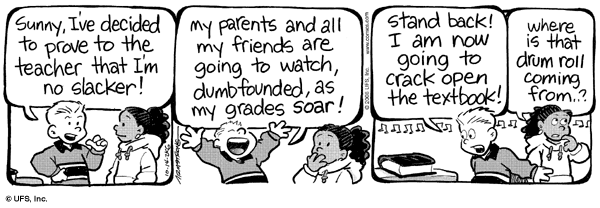
But everyone surely has a different "studying style".
More importantly, the way that you are studying right now might not be the best for
you:
How would you know? Easy: If your grades aren't what you'd like
them to be, then you probably need to change how you study!
One important clarification before we begin:
Studying may include doing homework, but it is also a lot more,
as you will see.
(So, if you say that you have no homework and that therefore
you can't, or you don't have to, study, you're mistaken!)
I am going to give you some suggestions on how to study efficiently. They
worked for me when I was in high school, college, and graduate school.
Not only that, but they worked equally well for me in humanities courses
(like philosophy and literature) and in science courses (like math and
computer science).
But, to the extent that everyone's styles may
be different, some of my suggestions may not work for you, at least not
without some individual modifications.
Nevertheless, I urge you to
try them. Most successful students use them (or some slight
variation of them).
Please feel free to send me suggestions for studying that worked for you. I will try to include them in further versions of this guide.
2.1. School is a full-time job. And managing your time is important.
2.2. Set yourself a grade goal. If you don't meet it, cut down on
non-school activities. (If you can't, because you're working for a
living, then consider dropping down to part-time schooling.)
2.3. For some tips on managing your time during exams,
see below.
2.4. For some tips on managing your time when doing projects,
see below.
Just as
different
students may have different learning or studying styles,
different teachers have different
teaching styles (and often these clash with the students' learning styles!):
Consequently,
different classroom settings will require different note-taking
techniques.
But the suggestions here are general enough to work in most situations.
Should you concentrate on taking notes or should you concentrate on
understanding what you are learning?
A related idea is based on a system of shorthand called Speedwriting: There used to be
ads in the New York City subway system that read something like this:
The key idea in abbreviating is to use abbreviations that will make sense
to you. You can put an abbreviation key in the margin of your
notebook for any abbreviations that you make up on the spot.
I suggest always doing the latter, but
also doing the former as often as possible.
One technique
that I use to be able to distinguish my own questions or comments from the
rest of the notes is to put them in the margin and/or to surround them
with big, bold square brackets
[like this.]
By the way, if you have a question, especially if you need clarification
of something that the teacher said or wrote (possibly because it was
inaudible or illegible), ask it!
The title was not "Take Notes in Class & Study Them
at Home".
Of course you should study your class notes at home; but just
(re-)reading them is too passive.
One of the themes of this guide
is that
It is all too easy when
just reading passively to have your mind wander or even to fall
asleep:
Moreover, notes are often incomplete or sketchy; just reading
such notes won't help. And a few days or months after you take them, they
may very well be illegible or incomprehensible.
Finally, if you don't do something active with your notes, you run the
risks of having unorganized notes or of misplacing them.
What I suggest is that you study your notes by re-writing them:
The main idea behind re-writing your "raw" class notes (besides making
them more legible and organized) is that the very act of copying them is
one of the best ways of studying them! Further study of your class notes
can then be done from these "cooked" ones that are neater, more legible,
more organized, and more complete. I will suggest ways to do this later.
Use this opportunity to fill in gaps
from your memory while they are still fresh in mind. You may find that
you have questions, perhaps something you missed or don't understand, or
even a "substantive" question. If so, good! Make a note of your
question and ask it in class next time!
Use this opportunity to
(re-)organize your notes in a more logical or coherent fashion. You could
write your permanent notes in an outline form if that seems suitable: You
don't have to follow any "official" or formal outlining style (e.g.,
using the I.A.1.(a)(i) format or the (sometimes silly) rule that there
must always be at least two subsections, never just one) — after all,
these are your notes. Personally, I like to number main ideas (and
separate them with a line), using
an "indented bullet" style for details:
Also, typing class
notes into a computer file can be inconsistent with my recommendation to
re-write your class notes.
Worse, you may be tempted to use the computer that you're ostensibly
taking notes on to surf the Internet, look at email, or chat with
friends. Don't! (For an interesting debate on this topic, see
Adams 2006.)
For that matter, turn off your computer in class. And your iPod. And
your cell phone. And your pager. And anything else that might distract
you. For reasons why, see:
Study hard subjects first.
Study in a quiet place, with as few distractions as possible.
If you read without thinking, I guarantee that
your mind will eventually wander off, your eyes will eventually glaze
over, and you will fall asleep—it's a form of self-hypnosis.
"…an undeniable truth: that in the pursuit of knowledge, slower
can be better."
The first step in reading actively is to read s-l-o-w-l-y. Here is
an algorithm (i.e., a procedure) for
how to read any text, in any subject, slowly and actively:
Since there is no next sentence (because the Boolean test in the
WHILE is false), you've understood the text!
For those of you who may not be familiar with how to read structured
computer programs such as this one, here's how it goes:
This algorithm has three major advantages:
How do you know whether you understand what you've read? Easy: After
each sentence, ask yourself "Why?" (Pressley & El-Dinary 1992).
For more information on slow reading, see:
But now suppose that a few months (or a few years) later, you want to find
that interesting passage that related to, say, consciousness; how will you
find it?
These notes can then be used later if you write a term paper
or research paper that discusses the material in the text.
What about film or video versions?
It should go without saying that you should do your homework and do it on time.
Science and math courses (and some others, such as foreign-language
courses) often require you to do homework exercises or problem sets.
What?
That's right: You shouldn't study only for exams. And you shouldn't
study for the sake of exams.
You should "study for learning and understanding":
But in case you do want to study for that exam, here are some
suggestions:
The first rule is: Don't cram!
Earlier, I discussed managing your time. When
you have exams, time management becomes even more crucial.
Begin studying about 1 week before the exam.
For final exams, try to spend as much time as possible studying.
Most students don't realize this, because they have an "illusion of
competence" (that is, you think you know the material better than you
really do) when they re-read notes and textbooks
(Karpicke et al. 2009;
Belluck 2011),
especially when
re-reading passively instead of
actively.
One method of studying that is better than passive re-reading is the
"read-recite-review" ("3R") method: "Read the text, set the text aside
and recite out loud all that [you can] remember, and then read the text
a second time" (McDaniel et al. 2009).
More importantly,
you learn better and remember more from repeated testing
(from both in-class quizzes and from self-testing at home)
than from repeated reading (Karpicke et al. 2009).
(So when your instructor gives you lots
of quizzes or tells you to memorize basic facts, don't complain! That's
the best way to learn and to remember what you learn.)
The next few sections give you some suggestions on how to do this.
For subjects in which you will have to solve problems or write proofs,
solve lots of sample problems from your text or from other texts.
Then memorize the questions and answers—but do not
simply recite them by heart.
Recent psychological evidence suggests that people learn better by
making mistakes than by getting everything correct. So don't worry
about getting some answers wrong! (See Roediger III, Henry L.;
& Finn, Bridgid (2010),
"The Pluses of Getting It Wrong",
Scientific American Mind 21(1) (March/April): 39–41.
Why
write, and not merely recite?
Moreover, there is evidence that the kind of "self-testing" that you can
do with this technique is one of the best ways to study: "taking
practice tests (versus merely rereading the material to be learned) can
substantially boost student learning", according to
John Dunlosky,
"Strengthening the Student Toolbox: Study Strategies to
Boost Learning",
American Educator 37(3) (Fall 2013):
12–21.
For an exam with problems to solve or proofs to write, do the easy ones
first.
When you are all done, review your answers carefully.
And, when all of your exams are over, take heed… :-)
From
For Better or For Worse:
How do you make an outline? The suggestions that follow work for almost
anything you have to write.
These will be the main sections of your paper. In addition,
you should always have an
introductory section and a conclusion or summary section.
Once you've got your outline, start writing, using your outline and notes
as a guide.
By the way, it's always helpful for keeping track of where
you are in your outline, both to you as writer and
to your reader, to give each section and subsection a name, as I have done
in this document.
And don't procrastinate!
For some tips on how to procrastinate about
procrastinating, see:
On the other hand, for an argument in favor of procrastinationg,
see:
Abstract:
Right about now, you're probably asking yourself whether you really
have to do all of this. It seems like an awful lot of work.
Well, of
course, you don't have to do all of it at once. Try various of these
suggestions to see what works for you. Try some variations that may better
fit your learning style or personal circumstances. But, in the long run,
there's no quick and easy road to studying. It is hard work and
should take a lot of time.
So, do you really have to do all
of this? Yes (or things very much like them)—if you want to
really learn the material (and get good grades).
Finally, for what it's worth, here are some comments from students and
others who
have tried some of these methods:
Goldbaum, Ellen (2009, December 17),
"UB Professor's Online Study Guide Makes a Great Gift That Keeps On
Giving",
University at Buffalo NewsCenter.
Adams, Dennis
(2006),
"Wireless Laptops in the Classroom (and the Sesame Street Syndrome)",
Communications of the ACM
49(9; September): 25-27.
Belluck, Pam
(2011),
"Take a Test to Really Learn, Research Suggests",
New York Times (21 January): A14.
Callender, Aimee A.; & McDaniel, Mark A. (2009), "The Limited
Benefits of Rereading Educational Texts", Contemporary Educational
Psychology 34: 30–41.
Claxton, Charles S., & Murrell, Patricia H. (1987),
Implications for Improving Educational Practices,
ASHE-ERIC Higher Education Report No. 4 (Washington, DC:
Association for the Study of
Higher Education).
Glenn, David (2010, January 8),
"Customized Teaching Fails a Test",
Chronicle of Higher Education:
A1, A7–A8.
Holland, John L. (1966), The Psychology of Vocational Choice
(Waltham, MA: Ginn & Co.)
Karpicke, Jeffrey D.; Butler, Andrew C.; & Roediger III, Henry L.
(2009), "Metacognitive Strategie in Student learning: Do Students
practise Retrieval When They Study on Their Own?", Memory 17(4):
471–479.
Kolb, David A.
(1984),
Experiential
Learning: Experience as the Source of Learning and Development
(Englewood Cliffs, NJ: Prentice-Hall).
McDaniel, Mark A.; Howard, Daniel C.; & Einstein, Gilles O. (2009),
"The Read-Recite-Review Study Strategy: Effective and Portable",
Psychological Science 20(4): 516–522.
Pashler, Harold;
McDaniel, Mark;
Rohrer, Doug;
& Bjork, Robert
(2009),
"Learning Styles: Concepts and Evidence",
Psychological Science in the Public Interest
9(3): 105–119.
Sternberg, Robert J.
(1999),
Thinking Styles
(Cambridge, UK:
Cambridge University Press)
Swerdlow, Joel L. (1999, August),
"The Power
of Writing", National
Geographic 196(2): 110-133, 136.
Willingham, Daniel T.
(2018),
"Does Tailoring Instruction to 'Learning Styles' Help
Students Learn?",
American Educator
42(2) (Summer): 28–32, 43.
2. Manage Your Time
Your education should come first!






3. Take Notes in Class & Rewrite Them at Home
Outline and Index:
3.1. Take Notes
Good studying at home begins with good notes taken in class.
3.2. Take Complete Notes
The key idea of taking good notes in class is to
write down as much as possible.
There are several reasons to take notes that are as complete as possible:
3.3. Use Abbreviations
Taking complete notes will require you to write fairly quickly and, as a
consequence, to use abbreviations. Here are some that I use (many of
which I borrowed from other students and teachers), to give you an idea of
how you can abbreviate.
If you send text messages on your cell phone, then you know the sort of
abbreviations I'm talking about. Use them when you take notes in
class!
ABBREVIATION MEANING
betw between
ccpt concept
cd could
compn computation
compnl computational
comp complete
dn description
fn function
h. human
...g
(e.g., contg)...ing
(continuing)
...l
(e.g., compnl)...al
(computational)
lg language
mn mean
mng meaning
...n
(e.g., abbrvn)...tion
(abbreviation)
NB: note/note well/nota bene
pn proposition
prop property
re about (from Latin)
reln relation
qn question
...r
(e.g., compr)...er
(computer)
shd should
s.t. something/sometimes
(context should make it clear which you mean)
stmt statement
thot thought
w/ with
w/o without
wd would
wh which
& and
∨ or (this is a symbol from logic)
¬ not/negation sign
(this is a symbol from logic)

possible/possibly
(this is a symbol from logic)

must/necessary/necessarily
(this is a symbol from logic)

all/for all/every
(this is a symbol from logic)

some/there is/there are/there exists
(this is a symbol from logic)if u cn rd ths, u cn lrn spdwrtg
3.4. Neatness Doesn't Count.
Yet another key idea of note-taking is that you don't have to be
neat! You only have to be legible enough to be able to read
your notes a few hours (or, at most, a few days) later. The reason for
this
will become clear later.
3.5. Ask Questions & Make Comments
If you have a question or something comes to mind as you're taking notes,
you have two choices:
3.6. Copy Your Notes at Home
Recall that this section was titled "Take Notes in Class & Rewrite
Them at Home".
STUDYING MUST BE ACTIVE.
1. Main idea 1
- detail 1
- detail 2
- further detail 2.1
- detail 3
- further detail 3.1
- further detail 3.2
2. Main idea 2
3. Main idea 3
etc.
3.7. Don't Take Notes on a Computer
By the way, I do not recommend taking notes on a laptop
computer during class.
3.8. Don't Rely on the Instructor's Lecture Notes
Some instructors provide their own set of lecture notes, often on the
Web or in PowerPoint (or some other format).
3.9. Further Reading
4. Study Hard Subjects First & Study in a Quiet Place
When should you study or do your homework?
Willingham, Daniel T.
(2010),
"Have Technology and Multitasking Rewired How Students
Learn?",
Ask the Cognitive Scientist,
American Educator
(Summer): 23–28, 42.
5. Read Actively & Slowly, before & after Class
Outline & Index:
5.1. Read Actively, Not Passively
Whatever you have to read — whether it's a text book, a
work of fiction, a poem, an essay, an article from a journal or magazine,
or even a class handout — read it slowly and
actively:
5.2. Read Slowly.
—Gleick, James (2011), The Information (New
York: Pantheon): 404.
WHILE there is a next sentence to read, DO:
BEGIN { while }
Read it, SLOWLY;
IF you do not understand it, THEN
BEGIN { if }
re-read the previous material, SLOWLY;
re-read the incomprehensible sentence, SLOWLY;
IF you still don't understand it, THEN
ask a fellow student to explain it;
IF you still don't understand it, THEN
ask your Teaching Assistant (TA) to explain it;
IF you still don't understand it, THEN
ask me;
IF you are in an upper-level course & you still don't understand it, THEN
write a paper about it (!)
END { if }
END; { while }
5.3. Highlight the Text in the Margin
There are some other tricks for active reading. One, of course, is to
highlight important or interesting passages. There are several ways to do
this:
and underlining for a third round. (If you must, you could use
yellow
highlighter for a fourth round.)
5.4. Make Notes in the Margin
You should also make notes in the margin of the text (if there's
room, and if the text belongs to you).
5.5. Keep a Notebook
Highlighting has the disadvantage that it
can lead you to highlight everything, and margins have the disadvantage
that they are often too
small for making comments.
5.6. Read Literature Quickly and Passively the First Time.
Earlier, I said that there was an exception to this
method of slow and active reading:
5.7. Read Before and After Class
Ideally, you should read a text at least twice:
6. Do Your Homework
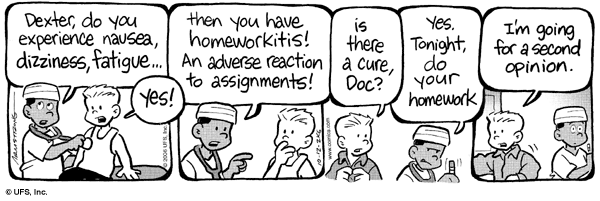
7. Study for Exams
Outline:
7.1. Don't Study for Exams!
7.2. Manage Your Time
DAY PART OF DAY WHAT TO DO
Day 1 morning study for exam #1
afternoon study for exam #2
evening study for exam #3
Day 2 morning study for exam #1
afternoon study for exam #2 or #3 (or both)
evening study for exam #1
Day 3 morning study for exam #1
afternoon take exam #1
evening study for exam #2
Day 4 morning study for exam #3
afternoon study for exam #2
evening study for exam #3
Day 5 morning study for exam #2
afternoon take exam #2
evening study for exam #3
Day 6 take exam #3
7.3. How Not to Study
Believe it or not,
re-reading your textbook has "little or no benefit" when you are
studying for a test. (Callender & McDaniel 2009;
see also
John Dunlosky,
"Strengthening the Student Toolbox: Study Strategies to
Boost Learning",
American Educator 37(3) (Fall 2013):
12–21.)
7.4. Make a Study Outline
Use your recopied class notes, together with your highlighted text and
notebook, to make an outline of the material.
7.5. Write Sample Essays & Do Sample Problems
For subjects in which you will be expected to write essays, either
"psych out" the teacher and make up some plausible essay questions, or
get copies of old exams that have real essay questions on them.
7.6. Make "Flash Cards"
For any subject, you can make a set of "flash cards".
7.7. Stop Studying When You Feel Confident
How do you know when you've studied enough?
8. Take Exams
First, read the entire exam all the way through.
For an essay question, do a "mind dump":
9. Do Research & Write Essays.
Outline:

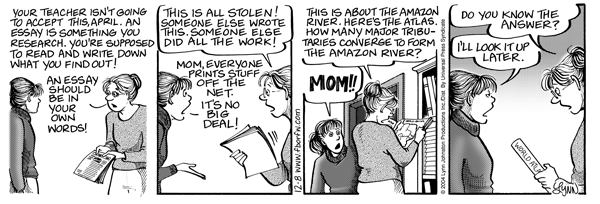
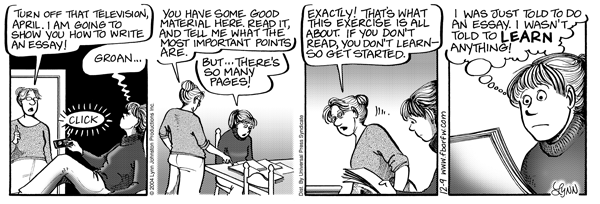
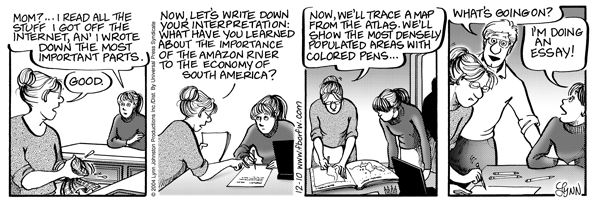

9.1. Choose Topic Carefully
Choose your topic wisely.
9.2. Do Research
Once you have a topic and have found appropriate resource materials,
read
them slowly and actively, and be sure to
keep a notebook.
9.3. Make an Outline
This stage may require several iterations.
intro topic1 topic2 topic3 conclusion
9.4. Write, Using Your Outline
9.5. Edit
After you've written your first draft, re-read what you wrote, using the
method of slow and active reading, and revise
(or "edit") what you wrote.
9.6. Manage Your Time
Slatalla, Michelle (2007),
"The Big Dilly-Dally",
New York Times Education Life
(7 January): 14–15.
9.7. Some Interesting Online Articles on Writing:
10. Do I Really Have to Do All This?
11. Are There Other Websites that Give Study Hints?
Yes; here are some that looked good to me; many of them have further
links for you to follow:
(2002),
"The Not-the-13th-Grade Page:
A FREE Online Guide to College Success"
References
"An Assortment of Learning Styles",
Chronicle of Higher Education
(8 January 2010): A8; published online 15 December 2009.
Mayer, Richard E. (2009),
"Editorial: Advances in Applying
the Science of Learning and Instruction to Education",
Psychological Science in the Public Interest
9(3): i–ii.
Text copyright © 1999–2024 by William J. Rapaport
Cartoon links and screen-captures appear here for your enjoyment and are not meant to
infringe on any copyrights held by the creators.
For more information
on any cartoon, click on it, or contact me.
(rapaport@buffalo.edu)
https://cse.buffalo.edu/~rapaport/howtostudy.html-20240214